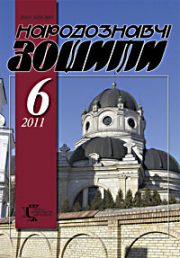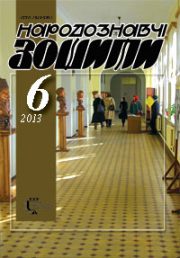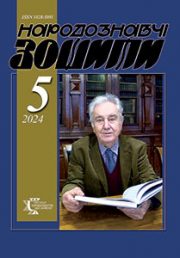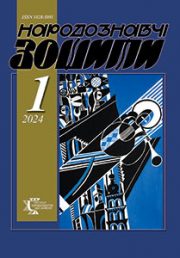The Ethnology Notebooks. 2024. № 5 (179), 1295—1307
UDK 745/749:061:069.4/5+398.332.12(045)(477.8)”19″
DOI https://doi.org/10.15407/nz2024.05.1295
TESLIUK Valentyna
- ORCID ID: https://orcid.org/0009-0004-4943-1175
- Head of the Funds Sector, Leading Custodian of the Pysanka Fund,
- Museum of Ethnography and Crafts,
- Institute of Ethnology of the National Academy of Sciences of Ukraine
- Contacts: e-mail: valentyna_teslyuk@ukr.net
Abstract. The relevance of the topic is driven by the need for an in depth analysis of the history of museum collections, which helps to assess the role of Ukrainian society in the development and preservation of Ukraine’s cultural heritage. Pysanka collection of the Museum of the Shevchenko Scientific Society (hereinafter — the NTSh Museum) is the object of the study. It aims to analyze the history of this collection and to evaluate the role of Ukrainian intelligentsia in the development and regional diversity of this collection. The chronological scope of the study covers the period of 1900s — 1940.
The research methodology is based on the application of a number of methods of museological and historical research, in particular, the chronological method, the principles of historicism, document analysis, and systematization.
The main sources include the inventory books of the NTSh Museum, as well as the SSS chronicles and scientific works on the history of the NTSh Museum collection. The article emphasizes the leading role of Ukrainian society in the development of the pysanka collection. For the first time, the specific contribution of Ukrainian scientists, researchers, public figures, teachers, priests, gymnasium students, and other donors to the museum collection is outlined. Two stages of the collection creation (before the First World War and the interwar period) are identified. In addition to chronological boundaries, they differ in the level of involvement of Ukrainian society in collecting and transferring pysankas to the Museum and in regional diversity. At present, pysanka collection of the NTSh Museum is in the Pysanka Fund of the Museum of Ethnography and Crafts of the Institute of Ethnology of the National Academy of Sciences of Ukraine.
Keywords: Shevchenko Scientific Society Museum, pysanka, collection, Shevchenko Scientific Society inventory books, appeal, donors.
Received 23.10.2024
REFERENCES
- Hembarovych, M.T., Hurhula, I.V., & Ivasiuta, M.K. (1959). From the history of the Ukrainian State Museum of Ethnography and Art Craft of the Academy of Sciences of the Ukrainian SSR. Materials on ethnography and art history, 4, 3—12 [in Ukrainian].
- Skrypnyk, H. (1979). From the history of ethnographic expositions of Ukraine. Folk creativity and ethnography, 4, 87—92 [in Ukrainian].
- Hontar, T. (1992). Ethnographic collections of the Museum of the National Academy of Sciences. From the history of the Shevchenko Scientific Society. Notes of the Shevchenko Scientific Society. Proceedings of sections of ethnography and folkloristics (Vol. CCXXII, pp. 417—427) [in Ukrainian].
- Sapeliak, O. (2000). Ethnographic studies in the Shevchenko Scientific Society. Lviv [in Ukrainian].
- Nadopta, A. (2012). The role of public, scientific organizations and churches in the formation and formation of the Ukrainian ethnographic museology of Galicia at the end of the 19th—30s of the 20th century. Ethnological notebooks, 4 (106), 758—774 [in Ukrainian].
- Kushnir, V. (2021). Museum of the Shevchenko Scientific Society. (1892—1940). Lviv: Institute of Ethnology of the National Academy of Sciences of Ukraine [in Ukrainian].
- (1909). Chronicle of the of the Shevchenko Scientific Society (Vol. 39) [in Ukrainian].
- (1910). Chronicle of the of the Shevchenko Scientific Society (Vol. 47) [in Ukrainian].
- (1912). Report from the museum for the period from October 1 to December 31, 1912. Chronicle of the of the Shevchenko Scientific Society (Vol. 52) [in Ukrainian].
- (1913). Report for 1912. Chronicle of the of the Shevchenko Scientific Society (Vol. 53, issue I) [in Ukrainian].
- (1913). Monthly report: January-April. Chronicle of the of the Shevchenko Scientific Society (Vol. 54, issue II) [in Ukrainian].
- (1913). Report from May-August 1913. Chronicle of the of the Shevchenko Scientific Society (Vol. 55) [in Ukrainian].
- (1930). Chronicle of the of the Shevchenko Scientific Society (Vol. 69—70).
- (N. d.). Inventory book of the Shevchenko Scientific Society Museum. No ІІ. Inventory numbers 6044—8864, 13220—13229, 13265—13305, 13310, 13654—13662, 14172—14191, 15952—15953, 15963, 15966—15989, 16188, 16217—16231 [in Ukrainian].
- (N. d.). Inventory book of the Shevchenko Scientific Society Museum. No ІIІ. Inventory numbers 17134—17136, 17142—17147, 17177—17199, 17201—17218, 17233—17237, 17239—17251, 17945—17963, 17968—17989, 18007—18020, 18116—18210, 18224, 18250—18263, 18275—18278, 18787—18792, 18794—18800, 18804— 18814, 18818—18840, 18842—18866, 18903 [in Ukrainian].
- (N. d.). Inventory book of the Shevchenko Scientific Society Museum. No ІV. Inventory numbers 18990, 19016—19026, 19061, 19070, 19071, 19143—19145, 19278, 19331, 19332, 19342—19349, 19434—19442, 19473—19476, 20069, 20192, 20193, 20196, 20197, 20199, 20202—20204, 20228—20232, 20236— 20250, 20259, 20260, 20262—20264, 20266, 20273, 20274, 20300, 20310 [in Ukrainian].
- (N. d.). Inventory book of the Shevchenko Scientific Society Museum. No V. Inventory numbers 20519, 20600—20604, 20661, 21036, 21156, 21273, 21302, 21311—21319, 21323, 21329, 21330, 21375—21377, 21379—21383, 21387—21390, 21394—21406, 21435, 21440, 21476, 21487—21498, 21607, 21621—21628, 21784, 21909—21914, 21947, 22101, 22037—22071, 22093 [in Ukrainian].
- (N. d.). Inventory book of the Shevchenko Scientific Society Museum. No VІ. Inventory numbers 22758, 22766, 22798—22800, 22805—22807, 22951, 23042, 23486, 23712—23715, 23722, 23723, 23807, 23867 [in Ukrainian].
- (N. d.). Inventory book of the Shevchenko Scientific Society Museum. No VIІ. Inventory numbers 24210, 24264, 24452, 24455, 24456, 24570, 24571, 24620, 24687, 24841, 25050, 25051, 25346—25354, 25944— 25946 [in Ukrainian].
- (N. d.). Inventory book of the Shevchenko Scientific Society Museum. No VІIІ. Inventory numbers 26277, 26278, 26336—26343, 26354—26358, 26367, 26368, 26371—26373, 26386, 26446—26448, 26603, 26604, 27352—27356, 27431, 27456—27458 [in Ukrainian].
- (N. d.). Inventory book of the Shevchenko Scientific Society Museum. No ІX. Inventory numbers 27475, 27478, 27567, 27603, 28322, 28702, 28703, 28907—28909, 28911—28923, 28928, 28929, 29024 [in Ukrainian].
- (N. d.). Inventory book of the Shevchenko Scientific Society Museum. No X. Inventory numbers 29365, 29699, 29733, 29805, 29822, 29883, 30033, 30056, 30132, 30230, 30231, 30238, 30259, 30265, 30301, 30302, 30336, 30339, 30359, 30364—30367, 30398, 30470, 30496, 30510, 30511 [in Ukrainian].
- (N. d.). Inventory book of the Shevchenko Scientific Society Museum. No XІ. Inventory numbers 30601, 30695, 30717, 30877, 30878, 31092, 31334, 31348, 31350, 31359 [in Ukrainian].
- (1898). Statute of the Shevchenko Scientific Society in Lviv. Notes of the Shevchenko Scientific Society, 4, 5—12 [in Ukrainian].
- Ivashkiv, H. (2003). The main stages of the formation of the folk ceramics collection in the Museum of Ethnography and Art Craft. Ukrainian Ceramological Journal, 2—4, 44—59 [in Ukrainian].
- Strilchuk, V. (2012). UGA lieutenant Pavlo Dubas is the creator of the history of Brida land. Independent cultural journal «Yi», 12. Retrieved from: https://www.ji.lviv.ua/n69texts/Strilchuk_Poruchnyk_Dubas.htm (Last accessed: 20.10.2024) [in Ukrainian].
- Hrebeniak, V. (1914, february 20 (7). Museum of the Shevchenko Scientific Society in 1913. Dilo, 38 [in Ukrainian].
- Marunchak, M.H. (Ed.). (1978). Horodenka region. Historical memoir collection. New York; Toronto; Winnipeg. Retrieved from: https://diasporiana.org.ua/wp-content/uploads/books/14565/file.pdf (Last accessed: 20.10.2024) [in Ukrainian].
- Hurhula, I. (1929). Pysanka of Eastern Galicia and Bukovyna in the collection of the National Museum in Lviv. Materials for ethnology and anthropology, 21—22 (1), 131—152 [in Ukrainian].
- Devda, A. (2018, march 23). Sava Nykyforiak. Rozhniv. The site of a wonderful village. Retrieved from: https://rozhniv.if.ua/index.php/vidomi-rozhnivchanu/202-sava-nykyforiak (Last accessed: 20.10.2024) [in Ukrainian].
- Kubiyovych, V. (Ed.). (1993). Encyclopedia of Ukrainian studies: in 11 vol. (Vol. 2). Shevchenko Scientific Society. Lviv [in Ukrainian].
- (N. d.). Inventory book of the Shevchenko Scientific Society Museum, XII, 194—195 [in Ukrainian].







